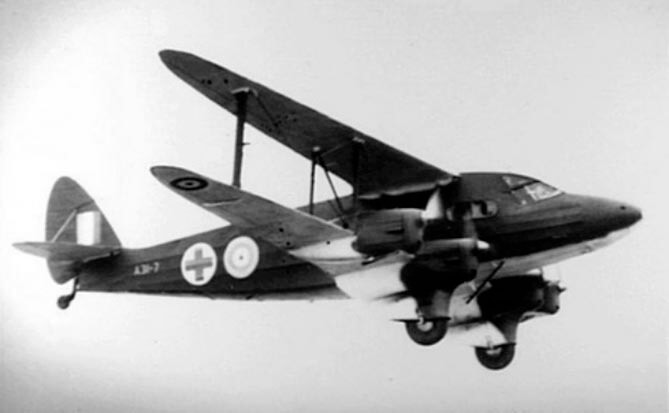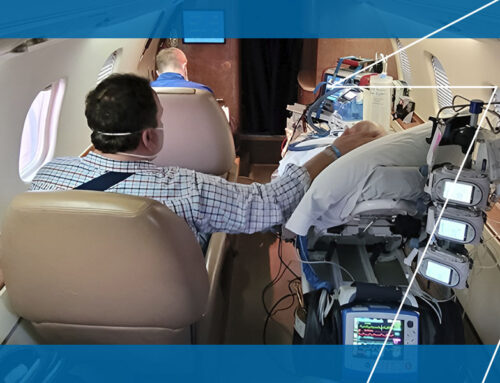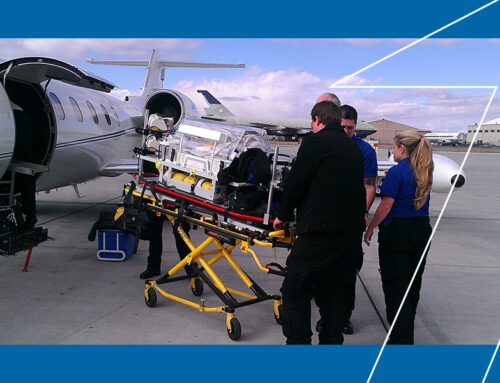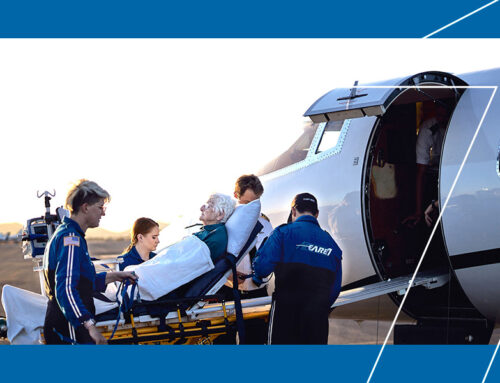In today’s modern era of medical transportation, fixed wing aircraft and helicopters frequently serve as air ambulances. Staffed with medically trained flight crews, they help transport patients from remote locations to hospitals for the provision of medical care. The fascinating history of medical air transportation testifies to the important changes air travel has made in the modern world during a relatively brief span of human history. Many of the sophisticated technologies employed by air ambulances today are rooted in the many advances made throughout the last century as air ambulances have take their current shape in today’s modern era of medical transportation.
The First Use of an Aircraft as an Air Ambulance
Most historians believe the earliest uses of aircraft as ambulances occurred just a few years after the Wright brothers perfected the first airplane in 1903.1 As people witnessed the time savings afforded by air travel, some observers realized this new invention could offer potentially significant benefits for people requiring medical attention.
Just as the outbreak of World War I soon led to the use of aircraft in aerial surveillance and combat operations, the conflict also provided a setting for the first documented air ambulance mission. In 1917, British forces in Turkey used a biplane to transport a wounded soldier to a medical facility for treatment. The flight required 45 minutes to complete, and saved the patient an arduous overland journey of three days’ duration.2,3
Expansion During The 1920s
Interest in the life saving potential of air ambulance aircrafts continued in many places during the 1920s. Reportedly, both France and Great Britain utilized aircraft as military ambulances during fighting in North Africa and the Middle East.3 In 1926, the United States authorized the newly established Army Air Corps to convey patients from Nicaragua to a military hospital in Panama some 150 miles away.3 At the time, the United States maintained a military force in Nicaragua and also administered the Panama Canal Zone.
Meanwhile, in remote parts of Australia, Canada and Scandinavia, pilots often flew visiting doctors into rural areas to treat patients. While not air ambulance journeys per se, these flights helped demonstrate the utility of aircraft in a medical context.5 By 1928, Australian authorities had organized a formal full-time Royal Flying Doctor Service to assist people in isolated communities.4
The 1930s And World War II
Widespread public interest in aviation continued during the 1930s. In 1932, the Schaefer Ambulance Service became one of the first established modern ambulance services in the USA. The private company based its operations in Los Angeles, California and provided a variety of transportation options, which by 1947 included air ambulance flights.3,5,5 Founder Walter Schaefer would help establish the California Ambulance Association after WWII which helped to further the growth of the air ambulance industry.5
As geopolitical tensions increased before the outbreak of WWII, air ambulance transport flights also gained the attention of the German military. Reportedly in 1936, German hospitals supplied medical care to fascist partisans flown to them in air ambulance flights from Spanish battlefields.2 By the end of the decade, Swiss air ambulances also transported injured skiers to local hospitals for treatment.2 At this point in history, the potential for air travel to save lives had become clear.
World War II And Beyond
During WWII, the United States military also took notice of the potential for air ambulances to save lives. Reportedly, the U.S. evacuated wounded British soldiers from the ground in Burma in April, 1944 for medical treatment. Both helicopters and fixed wing aircraft would eventually serve as military air ambulances. Helicopters assumed a more prominent role due to their enhanced maneuverability. These aircrafts served as U.S. military air ambulances during both the Korean War and the Vietnam War.6
By 1966, medical authorities in the U.S. widely recognized the urgency of transporting trauma patients to well-equipped hospitals for treatment. The National Academy of Science issued a policy paper urging civilian hospitals to embrace the potential of medical air ambulance flights to aid car crash victims and other critically ill patients.6 This document played an important role in the establishment of a modern nationwide emergency medical response system in the U.S. It helped persuade St. Anthony’s Hospital in Denver, Colorado to launch the first hospital initiated air ambulance service in 1972.6
The Modern Era: Improving Standard of Care
Today, the essential role of air ambulance services has gained universal acceptance. Available services vary from one provider to another. Some companies specialize in emergency medical rescue or evacuation efforts. Others focus instead on the comfortable and safe transport of ailing or injured patients to (and from) medical facilities. Some providers also offer Commercial Medical Escort Services to accompany medically at-risk individuals cleared for commercial passenger flights.
In an effort to raise standards of care, the United States government and the Commission on Air Medical Transportation Systems (“CAMTS”) have developed guidelines for North American air ambulance providers.4 These accreditation standards allow air ambulance providers to demonstrate their qualifications and obtain the most current training and continuing education resources for flight crews and medical personnel. The EURAMI accreditation organization represents a similar effort to raise air ambulance provider standards for companies operating in the European Union and other regions.
A Remarkable History
Over the last century, air ambulances have grown into a crucial means of medical transportation for many patients. Patients in critical condition are able to reach proper medical treatment more quickly than ever and the speed of treatment can often mean the difference between life in death. In addition, patients are now able to access specialized medical treatment that is often not available locally, especially in rural areas. Lastly, as the air ambulance industry continues to evolve, so do the standards of patient care. Patients are now able to receive medical care in the air that is equivalent to that one would receive in a premier medical facility.
Do you have any thoughts on how the air ambulance industry will continue to evolve over the next century? Let us know in the comment section below!
[separator top=”40″ style=”none”]
1. https://www.history.com/topics/inventions/wright-brothers
2. https://travelcareair.com/air-ambulance-history/
3. https://en.wikipedia.org/wiki/Air_medical_services
4. http://www.mercyjets.com/history-of-air-ambulances/
5. http://www.schaeferamb.com/aboutus.html#history
6. http://www.airambulanceguides.com/history-of-air-medical-and-air-ambulance-services-in-the-united-states/
https://en.wikipedia.org/wiki/Air_medical_services




